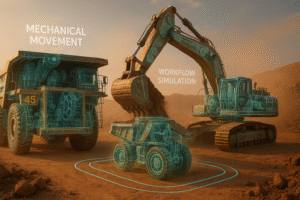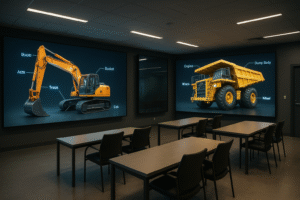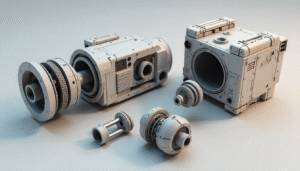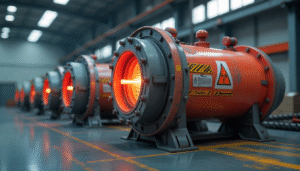Introduction
In today’s fast-paced digital landscape, visual content dominates marketing. Static images and traditional videos are no longer enough to capture attention. Enter 3D motion graphics for marketing—a game-changer that blends creativity and technology to create compelling brand narratives. With the ability to turn ordinary products into stunning visual experiences, 3D motion graphics designers play a pivotal role in modern advertising.
The appeal of 3D motion graphics lies in their ability to offer depth, realism, and interactivity that traditional video simply cannot match. This allows brands to communicate their messages more clearly, engage customers more deeply, and ultimately drive higher conversions. Whether it’s an ad, product demonstration, or social media campaign, 3D motion graphics provide a unique advantage in the crowded world of online marketing.
In this article, we’ll explore how 3D motion graphics are transforming product marketing, and why every modern brand should consider utilizing this technology.
Understanding 3D Motion Graphics for Marketing
What Are 3D Motion Graphics?
At its core, 3D motion graphics refers to animation techniques that use 3D modeling to create lifelike visuals. Unlike flat, two-dimensional graphics, 3D motion graphics add depth and volume to elements, creating a more realistic and immersive experience for viewers. These animations often combine movement, sound effects, and visual effects to deliver powerful brand messages.
For marketers, this means the ability to create realistic and engaging animations of products, people, or environments that wouldn’t be possible in traditional video or still imagery. From showing off intricate product features to creating entire worlds that convey a brand’s story, 3D motion graphics have endless possibilities.

How They Differ from Traditional Video Marketing
While traditional videos rely on live-action or basic animation, 3D motion graphics provide several advantages:
- Realism & Detail: 3D motion graphics offer hyper-realistic visuals that can highlight intricate product details, textures, and interactions. They allow for close-ups of product features that would be difficult to capture in a traditional video.
- Interactivity: Unlike traditional video, where the viewer is a passive observer, 3D motion graphics can be made interactive. Consumers can engage with 3D animations, rotating products, or zooming in on specific details for a more immersive experience.
- Versatility: Traditional video production is restricted by real-world limitations—weather, locations, actors, and so on. 3D motion graphics aren’t bound by these factors, giving designers the freedom to create unique and imaginative worlds for their brands.
The Role of 3D Animated Product Promotions in Branding
The Impact of Animated Storytelling on Consumer Perception
Storytelling is at the heart of effective marketing, and 3D animated product promotions are particularly effective in weaving compelling narratives around a brand’s products. Animation allows for the visual representation of a story—bringing products to life with context, motion, and emotional engagement. Consumers are more likely to remember a brand or product when it is part of a relatable story.
For example, a 3D animation can showcase how a product fits into a person’s daily life, helping the viewer visualize its benefits and usefulness. The result? An emotional connection that goes beyond the product’s features.
Why Brands Invest in 3D Product Animation
- Enhances Brand Storytelling: Brands are no longer just selling a product; they are selling an experience. With 3D animation, companies can tell stories in a way that resonates emotionally, creating a lasting impression on consumers.
- Provides a Competitive Edge: In an age of short attention spans, 3D animations stand out in a crowded marketplace. They offer a fresh, innovative approach to advertising that grabs attention and keeps it.
- Creates Highly Shareable Content for Social Media: The shareability of 3D animations on social media platforms can increase a brand’s exposure exponentially. Interactive and visually appealing animations are more likely to be shared by users, extending a brand’s reach.
Key Benefits of 3D Motion Graphics in Marketing
Increased Engagement and Conversion Rates
Studies have shown that consumers are more likely to engage with content that features visual elements. 3D motion graphics amplify this by transforming static imagery into dynamic, interactive content. This leads to higher engagement, and when used in product showcases, it can also boost conversion rates. For example, consumers are more likely to click a product ad that features a 3D animation demonstrating how the product works compared to a static image.
Enhanced Storytelling Through Visual Depth
Traditional video can deliver a story, but 3D motion graphics go further by adding layers of depth to the narrative. Imagine a 3D animation that shows a product being assembled, with every part moving in sync and revealing hidden functionalities. This immersive experience keeps the viewer engaged and focused on the product for longer periods.
Boosting Brand Recognition with Dynamic Animations
Branding is all about consistency and 3D motion graphics can reinforce brand identity through dynamic animations. A unique animated logo or product design can become instantly recognizable. Brands like Nike and Apple have already demonstrated how effective animated branding can be in boosting recognition and recall.
How 3D Motion Graphics Designers Elevate Product Marketing
Transforming Static Ideas into Dynamic Visual Experiences
A talented 3D motion graphics designer can take a product concept and turn it into a compelling visual experience. By combining technical skills with creative storytelling, they create animations that resonate with audiences on both an emotional and intellectual level. This dynamic transformation is what makes 3D motion graphics so powerful.
Creating Interactive and Immersive Product Presentations
One of the key advantages of 3D motion graphics is the ability to create interactive product demonstrations. Imagine a potential customer viewing a product online and being able to rotate, zoom in, and interact with it from every angle. This hands-on approach allows customers to fully understand a product’s features and build trust in the brand, driving higher purchase intent.
Enhancing Emotional Connection with Audiences
3D motion graphics can evoke emotions that enhance the viewer’s connection to the product. For example, a 3D animation that shows how a product improves the life of a consumer can foster positive feelings, making the viewer more likely to make a purchase.
Visual Storytelling with 3D Graphics: Captivating Your Audience
The Psychology Behind Visual Storytelling
Studies have shown that the human brain processes visual information 60,000 times faster than text. That’s why visual storytelling through 3D graphics is so effective—it allows brands to convey complex ideas quickly and effectively. Whether you’re explaining how a product works or telling a brand’s story, 3D motion graphics can communicate the message more engagingly and memorably.

How 3D Motion Graphics Simplify Complex Product Features
For products with intricate features or complex technology, 3D motion graphics are an excellent tool for simplifying explanations. Instead of relying on technical jargon, 3D animations can show exactly how the product works, breaking down complex concepts into digestible, visual narratives. This makes the product more accessible to a wider audience, from tech enthusiasts to casual buyers.
3D Product Visualization Services: A Game-Changer for E-commerce
High-quality 3D Renders for Online Product Showcases
For e-commerce businesses, providing potential buyers with detailed, high-quality images of products is essential. 3D product visualization services allow companies to offer customers an immersive online shopping experience by creating realistic 3D renderings of their products. Customers can see exactly what they are purchasing, eliminating any uncertainty and reducing the likelihood of returns.
How Interactive 3D Models Enhance Online Shopping Experiences
Interactive 3D models allow shoppers to virtually “handle” the product before purchasing. They can rotate, zoom in, and view the product from every angle, providing a more detailed and accurate representation of the item. This is particularly useful for products like furniture, tech gadgets, and fashion accessories.
Product Animation for Branding: A Competitive Edge
Why Animated Branding Strengthens Brand Recall
Animated branding—such as dynamic logos and branded motion graphics—adds a distinctive touch to a brand’s identity. Consistency in these elements helps reinforce brand recognition, ensuring that the brand sticks in consumers’ minds. Think about Coca-Cola’s animated commercials or the Nike swoosh moving across the screen; these brand assets are immediately identifiable.
Examples of Top Brands Using 3D Motion Graphics Successfully
Companies like Apple and Nike have set the bar high when it comes to using 3D motion graphics in their marketing campaigns. Apple, for instance, uses stunning 3D product animations in its ads to showcase the sleek design and features of its devices. Nike, on the other hand, incorporates 3D animations to demonstrate the performance and innovation of their sports gear.
Engaging Motion Graphics for Ads: Capturing Attention Instantly
The Role of Motion Graphics in Social Media Advertising
In a world where social media is flooded with content, engaging motion graphics are a powerful way to cut through the noise. Short, visually dynamic animations are ideal for platforms like Instagram, Facebook, and TikTok, where the window of attention is fleeting. 3D motion graphics allow brands to deliver their message in a way that grabs attention immediately.
How 3D Animations Increase Ad Click-Through Rates
Studies show that ads featuring 3D animations have higher engagement rates compared to static images. The dynamic nature of motion graphics encourages viewers to interact with the ad, leading to increased click-through rates and more conversions.
Case Studies: Successful 3D Animated Product Promotions
Examples of Businesses Leveraging 3D Motion Graphics Effectively
- Automotive: Companies like Tesla use
3D animations to showcase the advanced features of their cars, from self-driving capabilities to battery technology.
- Tech Gadgets: Apple’s product reveal events incorporate stunning 3D visuals to introduce new devices, highlighting their functionality and sleek designs.
- Fashion: Virtual try-on experiences powered by 3D modeling have become a huge trend in the fashion industry, with brands like Gucci using this technology to give consumers a chance to see how clothes will look on them before making a purchase.
Data-Driven Insights on the Impact of 3D Animation in Marketing
- 80% of consumers are more likely to purchase after watching a 3D animation.
- 3D video ads have a 150% higher engagement rate than static ads.
Conclusion
3D motion graphics are revolutionizing marketing by making products more engaging, interactive, and memorable. By integrating 3D animated product promotions into your marketing strategy, you can elevate brand storytelling and captivate your audience in ways that traditional video and images simply cannot. Whether you’re looking to enhance your product’s presentation, improve consumer engagement, or strengthen brand recall, 3D motion graphics offer an invaluable tool in today’s digital marketing world.
FAQs
1. How do 3D motion graphics improve marketing performance?
They increase engagement, enhance storytelling, and drive conversions through visually compelling animations.
2. What industries benefit most from 3D animated product promotions?
E-commerce, tech, automotive, and fashion industries benefit greatly from 3D animations.
3. How much does it cost to create a 3D product animation?
Costs vary based on complexity but range from $500 to $10,000+.
4. What is the difference between 3D product visualization and motion graphics?
Visualization focuses on static 3D renders, while motion graphics add dynamic animations.
5. How can I find the best 3D motion graphics designer for my brand?
Look for experience, a strong portfolio, and expertise in storytelling.






